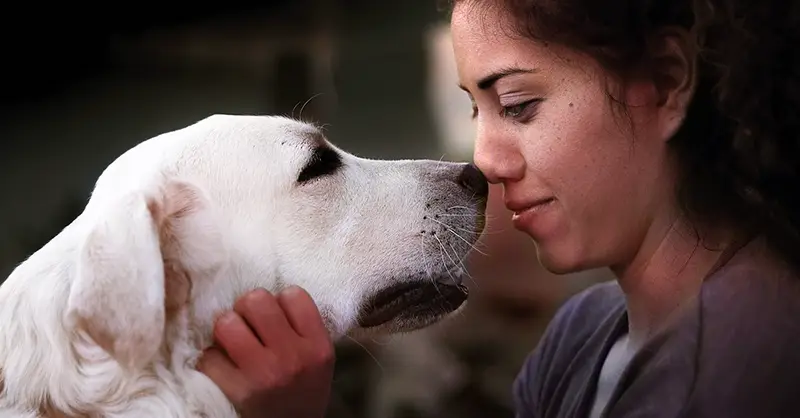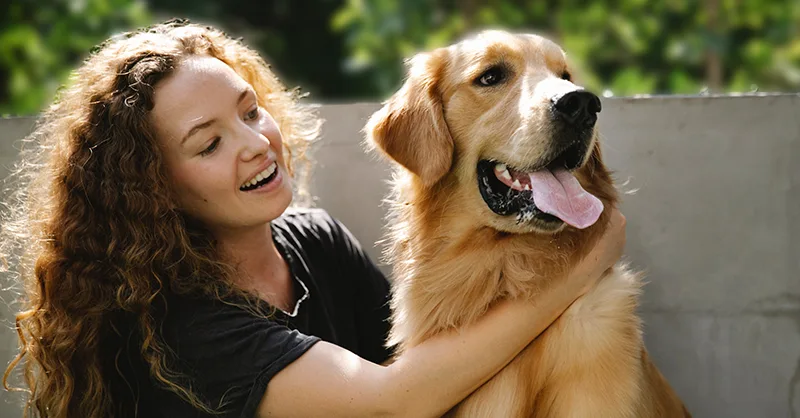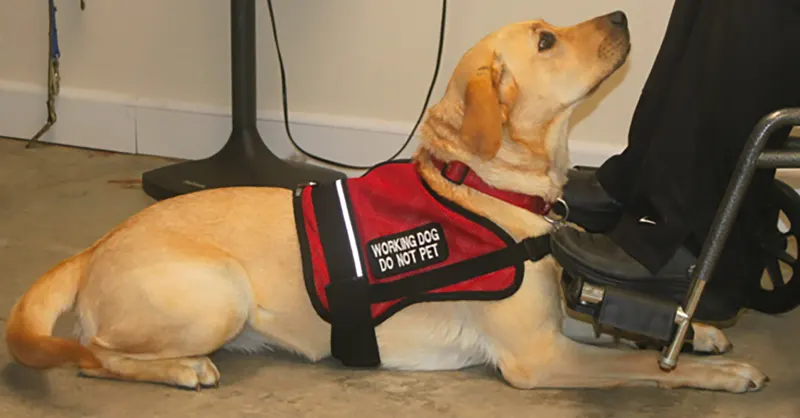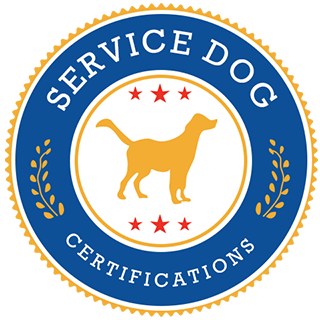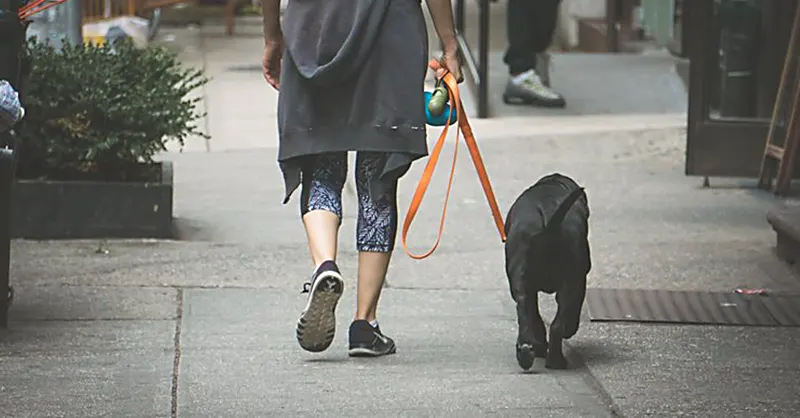Archive for the ‘Service Dog Tips’ Category
Service dogs can be of great help to people with disabilities. However, in order to get the most from these loyal companions, they need to go through extensive service dog training.
Just to give you an overview of requirements, the dog needs to be able to perform a disability-related task for their handler/owner. In addition, you must be familiar with acceptable training techniques and be educated about canine care and health. Furthermore, understanding of local public access laws and proper behavior is a must.
Image by k9_skee (Instagram)Other than just being your living medical device, these dogs will also become your best pals. They will take care of you, but they will also depend on you to provide food and shelter. You can build an incredible bond with your service dog and make both your lives better.
Basic Rules About Service DogsService dogs are recognized by the law as trained working dogs that perform tasks for persons with disabilities. Disabilities can include both physical and mental impairment. It’s critical that the dog can perform specific tasks that directly relate to owner’s disability. This can include anything from opening doors for people in wheelchairs to warning the owner of an impending seizure.
They are not considered pets and must be desensitized to distractions. Service dogs need to focus solely on their owners and ignore all distractions such as traffic, children, etc.
Although training is essential for service dogs, that doesn’t mean that you can’t train the dog yourself. Many people choose to train their service dog themselves because professional service dog training can be a long and expensive process. And in the end, even professional trainers can’t guarantee that your dog will be able to become your service dog.
Image by theserviceunicorn (Instagram)Service dog training can take up to two years and these dogs usually wear a vest in public for easy identification. Any dog can enter service dog training, regardless of breed or age. However, unless they have a certain set of characteristics, they might not do well.
Service dogs need to be:
Willing to please Ready to follow owners everywhere Calm and friendly Alert Socialized Nonreactive to public and strangers Quick to learn Able to retain information Guide DogsGuide dogs go through specific service dog training to help people with a visual impairment. These dogs bring a new sense of freedom and safety to their owners by:
Helping avoid obstacles and moving vehicles Signaling changes in elevation levels Locating persons or objects on command Retrieving and carrying objects Hearing DogsHearing dogs assist people with hearing impairments by:
Alerting to sounds or presence of other people Retrieving dropped objects Carrying messages Warning people to approaching vehicles Service DogsAs stated before, service dog training enables these loyal animals to perform a variety of tasks. Depending on the owner’s disability and needs, service dogs can undergo training for mobility assistance and medical assistance. Medical assistance can also include autism assistance and psychiatric assistance.
Image by thekingofhellonduty (Instagram)What these superhero canines can do for their owners is amazing and it’s all achievable through training.
Check out a list of service dog tasks and services below: Open and close doors, drawers, and cabinets Turn lights on and off Help people get dressed or undressed Assist persons to an upright position Move feet and arms onto wheelchair footrests and armrests Prevent falls and provide stability Call 911 in case of emergency Identify and alert to symptoms Bark or find help on command Find places, vehicles, or their owner when disoriented and bring to safety Assess owner’s safety and guide away from stressful situations Help with insomnia and interrupt nightmares Interrupt flashbacks and prevent self-harming behaviors using tactile stimulation Detect allergens, low and high blood sugar levels Provide deep pressure therapy General Service Dog TrainingAs you can see, some of these behaviors are pretty complex for a canine (such as calling 911 in case of emergency). And some of these behaviors are something that even humans couldn’t do (sense and alert owner to seizure or diabetes attack).
For those reasons, service dogs require extensive and complex training. Even then, there’s no guarantee that a dog will be able to become a full-time service animal.
Image by skip_thedoodle (Instagram)As for the US, there are no specific regulations regarding service dog training. However, international standards prescribe at least 120 hours of training over six months. Out of this quota, a minimum of 30 hours should include public access skills. Sometimes, service dog training can last up to two years as all dogs are different. Some canines need more time to learn to heel while some have a problem with handling distraction. In addition, learning specific complex tasks can be extremely time-consuming.
If you want to train the animal yourself, an ideal service dog training guide would include a few things.
First, you should assess whether your dog is fit for the position. Secondly, it’s important to establish a sequence for training. Less complex tasks and commands should be taught first.
This means the fundamentals include standard Service Dog commands such as “come“,“sit“,“stay“,“lie down“ and “heel“. Then, you should test the dog’s obedience in different environments and ensure that he follows commands no matter where you are and what’s going on around you. Finally, you can start teaching the dog specific tasks you want him to perform.
Arm yourself with lots of patience if you decide to go down this path rather than getting a trained service dog. If you get stuck, ask a professional trainer for help.
Disability-Related Service Dog TrainingIf your dog behaves well, is eager to please and intelligent, he’s a good candidate for service dog training. Focusing on their handler at all times and performing disability-related tasks is not all service dogs do. Other than these, they need to perform a number of other tasks on command. In order for the dog to pass a test, he must respond to handler’s first command 90% of the time, regardless of the environment.
Image by best_friend_k9 (Instagram)This even includes potty on command. Yes, you heard that right. Instead of staying outside forever, when you give the order to go, the dog must do his deed. Sounds like every owner’s dream, right?
A public access test is another requisite and you need to train the dog in a variety of different settings. This part of training is called desensitization. It’s basically teaching your dog to ignore all distractions and to focus on his handler and tasks.
As for the specific disabilities that can benefit from service dogs, they include a number of conditions. These conditions can be either physical or mental, obvious or not obvious.
Here’s a list of common tasks service dogs perform for their handlers: Guiding the blind Alerting the deaf to noises Pulling a wheelchair Retrieving items Alerting to seizures or diabetes attacks Reminding persons to take prescribed medication Calming people with PTSD during anxiety attacksKeep in mind that if you have a service dog, you can access all public areas with your companion. In addition, people can’t ask you about specifics regarding your disability. All they can ask you is whether your dog is a service animal and what tasks he can perform for you. You don’t need to answer any other questions or show them what the dog does for you.
Dogs are a man’s or woman’s best friend. We have trained them for generations to help us hunt, farm, and raise livestock. Now that most of us do not have farms or hunt for food, our dogs are here to support us in different ways.
You can have a legitimate certified Service Dog even if you are not blind or wheelchair-bound. If you suffer from a disability, you are legally qualified to have a service dog. Below are the steps to legitimately certify your service dog.
Step #1 – Train Your Dog, No Shaming AllowedAdmitting to yourself that you could benefit from having a service dog can be the hardest step. Facing your own disability and admitting you need support can make you feel weak. This is not true. Standing up for yourself and seeking self-care is an essential part of growing and healing.
Training your dog to perform tasks for your disability is the first step. To learn more about how to make your dog a service dog, read this post.
Once you have trained your service dog, remember to travel with your certified Service Dog with confidence and be proud of your accomplishment. Training your dog to provide a service for you will create a stronger bond between you and your furry companion.
Step #2 – Legal Education, Understanding Service Dog LawsService Dog rights are clearly defined by the ADA. However, there are still a few facts that people commonly get wrong.
You have rights when it comes to owning a legitimate service dog.
Fact or Fiction? #1 – Service Dogs require a doctor’s note.FICTION… – Service Dogs do NOT require a doctor’s note.
Fact or fiction? #2 – Service Dogs cannot be Pitbulls or large dogs such as Dobermans or Great Danes. Only Golden Retrievers can be service dogs.FICTION… – There are no breed, weight, or age requirements for Service Dogs. As long as the dog is well trained and can perform a task that aids in their handler’s disability, they can be considered a service dog.
Fact or Fiction? #3 – Landlords cannot charge a pet deposit for a service dog or deny them housing access.FACT! – Service dogs have public access rights to all public places including housing. A Service Dog is NOT a pet and is categorized as a medical tool.
Step #3 – Practice, Practice, PracticeOne of the most nervous parts of having a Service Dog is traveling with them in public. Training your Service Dog at home can be much easier since you are in a comfortable environment and your Service Dog has fewer distractions. Below are tips on how to practice training with your service dog.
Tip #1 – Train your service dog at homeMaking sure you and your service dog are speaking the same language is key. Remember, your dog does not actually understand English. They associate the sound you are making with the task that they understand you would like them to perform. Making sure you and your service dog are communicating clearly is the first step to having a strong relationship.
Tip#2 – Train your service dog at a parkAfter you and your service dog are speaking the same language, it is important to start practicing and training in public places that allow for dogs, such as a park. Parks are excellent places to train your service dog since this space allows for dogs, there are plenty of distractions for your dog to overcome, and it is a beautiful way to spend an afternoon!
Tip #3 – Train your service dog at public places that are service dog-friendlyAlthough every place in the US is required to grant access to service dogs, some places will refuse to follow the law. Once you are confident in traveling with your service dog, we recommend standing up for your rights. We will discuss this in more depth later in this post. However, when you are first training your service dog, we recommend only exposing yourself to kind and safe environments.
A good way to practice traveling with your service dog is to call a restaurant with an open patio. Inform them you are traveling with your service dog and request that they reserve a table in the corner for you. You can have your service dog practice sitting under the table and waiting patiently for you. They will experience various distractions such as food and people wanting to pet them. Make sure you keep control of your service dog so both of you can gain confidence.
Step #4 – Legitimate Service Dog CertificationThe ADA only allows employees and others to ask you two questions regarding your service dog.
Question #1 – Is that a service dog? Places can only ask you this question if it is not clear that your dog is a service dog. If your Service Dog is wearing a service dog vest, they should not need to ask you this question.
Question #2 – What task does your service dog provide for you. You can inform them the specific task your Service Dog provides for you and show them your Legitimate Service Dog Certification. They are not allowed to ask you to show them the task or ask specifically about your disability.
Step #5 – Advocacy for Service Dog RightsEvery service dog handler should become a Service Dog Rights Advocate. Too often we have Service Dog handlers accusing others of not being “legitimate” service dog handlers. This is discrimination and self-hate. Please understand that people are fighting disabilities that you may not be aware of. They have challenges in their lives that make having a Service Dog a bright light for them. Shining doubt on other Service Dog handlers is not right and we advocate against such emotional cruelty. Please be kind to others.
Under the Americans with Disabilities Act (ADA), service dog handlers have special legal rights. The ADA allows service dogs to accompany people with disabilities in all areas where the public is allowed to go. This includes businesses such as stores and restaurants, and public areas such as national parks, beaches, and libraries.
Under the ADA, a disability is defined as someone who has “a physical or mental impairment that substantially limits one or more major life activities” or “a person who has a history or record of such an impairment, or a person who is perceived by others as having such an impairment.”
Handlers of service dogs use their animals to help with a wide variety of disabilities. Generally, the disability can be:
A physical disability, such as mobility issues, blindness, and hearing impairment. A psychiatric condition, such as panic disorder, severe depression, and PTSD.Regardless of the type of disability the handler has, the service dog must be trained to work or perform tasks related to the disability. In the article, we will address four specific topics.
#1 – A service dog must have special training #2 – Registrations, IDs, vests and other accessories are frequently used and helpful, but optional #3 – Service dogs have special rights for housing #4 – Service dogs can travel with their handlers, even on flights #1 – A service dog must have special trainingBy definition, a service dog must be trained to work or perform tasks for a person with a disability. The task that the service dog is trained to perform must be directly related to the handler’s disability.
How service dogs help: For example, a service dog can be trained to assist a visually impaired person walk around in public environments or to pull a wheelchair for someone with limited mobility. Service dogs also help people with psychiatric conditions by performing tasks such as reminding their handlers to take medication or providing pressure therapy during panic or anxiety attacks.
ADA compliance: In addition to the special training a service dog must have to help a person with a disability, it’s also important for the service dog to master basic obedience training. Under ADA rules, a service dog must always be under the control of its handler. Service dogs must be harnessed, leashed, or tethered (unless it prevents the service dog from effectively performing its tasks). If the use of a harness, leash, or tether is unsuitable, the handler must maintain control of their service dog through voice, signal, or other means.
A good service dog should maintain discipline, while focusing on its handler in public areas, especially those that are busy and filled with potentially distracting stimuli. It can be useful to subject the service dog to a public access test to ensure that it is ready to enter public environments filled with people, animals, and other distractions.
Who can train a service dog? A service dog can be trained by a professional or by the handler. There is no requirement to hire a professional or to take any particular course — if the handler is capable, they can train their service dog on their own. Training a dog to perform tasks reliably for a disability takes time, patience, and know-how.
If you have limited knowledge and experience in training a canine, you may want to consider enlisting the help of a professional dog trainer. A dog trainer can be helpful even if you plan to do most of the training yourself — they can give you a framework for training and useful tips.
#2 – Registrations, IDs, vests, and other accessories are frequently used and helpful, but optionalWhen you see a service dog handler out in public, you will often see the dog wearing a vest, and the handler will have an identification card that likely contains a registration number.
Service dog handlers commonly use Service Dog IDs and vests primarily for a couple of reasons:
They help indicate to others in the public that their dog is a working service animal that should not be bothered They help maintain privacy by curbing unwanted and intrusive inquiries about the service dog.Legal requirements: One common misconception regarding service dogs is that there is a legal requirement for them to be registered or to wear a vest. Some people also think that an identification card is mandatory for service dog handlers. Contrary to these beliefs, service dog handlers are not required to register their dogs, carry IDs, or have their service dogs wear vests.
Service dog handlers use these items voluntarily because they are useful. A staff person at a public establishment, however, cannot demand that a service dog handler show an ID card or put a vest on their dog in order to be granted accommodation on the premises. Many service dog handlers find ID cards and vests essential for being out in public. Most people are unaware of the specific details regarding ADA rules, and these tools provide an easy shortcut for service dog handlers to indicate that their dog is not a normal pet. If you’re interested in registering your service dog in a database, you can get started by clicking on the link below.
Once your dog is registered, you can order a service dog ID card, service dog certification, and even order a service dog vest. Again, while these items are optional, many service dog handlers find them incredibly helpful.
All service dog handlers should understand they have a right to privacy when they are out in public. If it is obvious what service the service dog provides, staff at a public establishment are not allowed to make any inquiries regarding your service dog. If it is not obvious what service the dog provides, staff can only ask two questions:
Is the dog a service animal required because of a disability, and if so, What work or task has the dog been trained to perform?They can’t ask a service dog handler for further details regarding their disability or require that the handler demonstrate that the dog can perform the task it has been trained for.
#3 – Service dogs have special rights for housingService dogs are not pets. Service dogs have special housing rights that are not granted to normal pets. If you are a service dog handler, you are permitted under Fair Housing rules to live with your service dog, even if your building has a strict policy that bans all pets. For purposes of Fair Housing laws, service dogs are not considered pets, and any policy that may apply to pets is inapplicable.
For example, if the building allows pets but not dogs over 50 pounds, or the building bans certain breeds such as pit bulls or Great Danes, those rules do not apply to service dogs. A housing provider cannot prevent a tenant from keeping a service dog in their home because the dog is of a certain breed or weight.
Exceptions and requirements: A landlord can only deny accommodation of a service dog in limited circumstances, such as if they determine that the service dog poses a safety or health threat to others. As with all service dogs, landlords can only verify a disabled person’s need for a service dog by asking the two questions discussed in the previous section. Unlike an emotional support animal which requires a letter of recommendation from a licensed healthcare professional, a service dog does not need any documented credentials.
#4 – Service dogs can travel with their handlers, even on flightsService dogs are also allowed to travel and fly with their handler at no extra cost. This means they can ride on public transportation such as trains and buses, and also in taxis. Under the Air Carrier Access Act, service dogs are allowed to accompany their handlers in the airplane cabin as well.
Traveling can be a stressful experience for any dog. It’s important that a service dog has been trained to handle situations such as crowded airports, trains, and airplane cabins. A service can be denied accommodation if it is disruptive and not under the control of its handler. Service dogs intended to be used for travel should be exposed to a wide variety of situations, so they remain calm when faced with novel environments. It’s important to properly acclimate a service dog for the type of journey you’re taking. Start with shorter trips on a plane or the bus so your service dog can learn to maintain composure when flying with you in scenarios like turbulence, longer trips, or crowded bus and train journeys.
If you are ready to register your service dog, click on the image below.